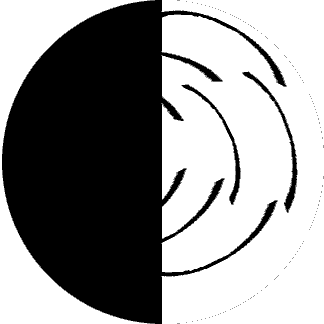 | Benham's Disk |  |
 | Benham's Disk |  |
This is my favorite visual illusion. You can spend hours playing with
this illusion and you can even make your own unique spinners too!
 In 1894, toymaker Mr. C.E. Benham discovered that a spinning disk with a particular pattern of black and white marks could cause people to see colors. Mr. Benham called his disk an "Artificial Spectrum Top" and sold it through Messrs. Newton and Co. Benham's Top (or Benham's Disk) has puzzled scientists for over 100 years. Here is how to make your own Benham Top:
| ||||||||||||||||
Special Notes
|
What's Happening? What Causes the Colors?The retina of the eye is composed of two types of receptors sensitive to light: cones and rods. Cones are important for color vision and for seeing in bright light. There are three types of cones, each of which is most sensitive to a particular wavelength of light. Rods are important for seeing in low light.It is possible that the colors seen in spinning Benham disks are the result of changes that occur in the retina and other parts of the visual system. For example, the spinning disks may activate neighboring areas of the retina differently. In other words, the black and white areas of the disk stimulate different parts of the retina. This alternating response may cause some type of interaction within the nervous system that generates colors. Another theory is that different types of cones take different times to respond and that they stay activated for different amounts of time. Therefore, when you spin the disk, the white color activates all three types of cones, but then the black deactivates them. The activation/deactivation sequence causes an imbalance because the different types of cones take different times to respond and stay on for different times. This imbalance in information going to the brain results in colors. Neither of these theories explains the colors of Benham's disk completely and the reason behind the illusion remains unsolved. |
? |

Did you know? |
The full text of the announcement of the
"Artificial Spectrum Top" in Nature,
51:113-114, 1894:
An "Artificial Spectrum Top," devised by Mr. C.E. Benham, and sold by Messrs. Newton and Co., furnishes an interesting phenomenon to students of physiology optics. The top consists of a disc, one half of which is black, while the other half has twelve arcs of concentric circles drawn upon it. Each arc subtends an angle of forty-five degrees. In the first quadrant there are three such concentric arcs, in the next three more, and so on ; the only difference being that the arcs are parts of circles of which the radii increase in arithmetical progression. Each quadrant thus contains a group of arcs differing in length from those of the other quadrants. The curious point is that when this disc is revolved, the impression of concentric circles of different colors is produced upon the retina. If the direction of rotation is reversed, the order of these tints is also reversed. The cause of these appearances does not appear to have been exactly worked out. |
Did you know? |
|
References
|

| BACK TO: | Vision Experiments | Games | Exploring the Nervous System | Table of Contents |
![[email]](./gif/menue.gif) Send E-mail |  Get Newsletter |  Search Pages |